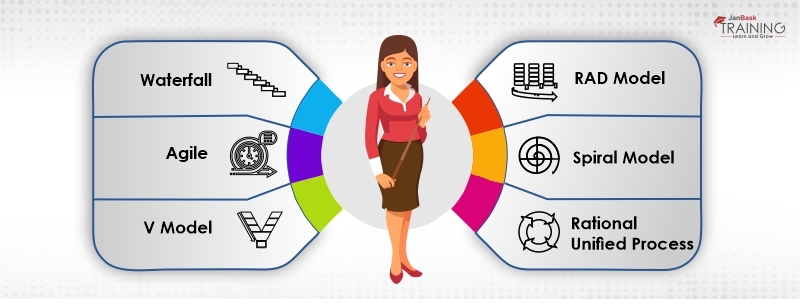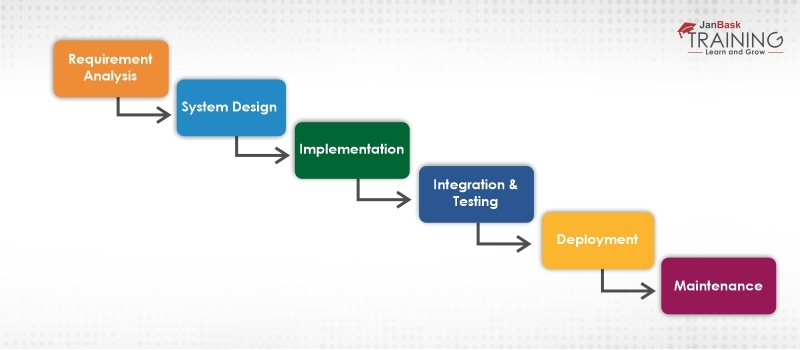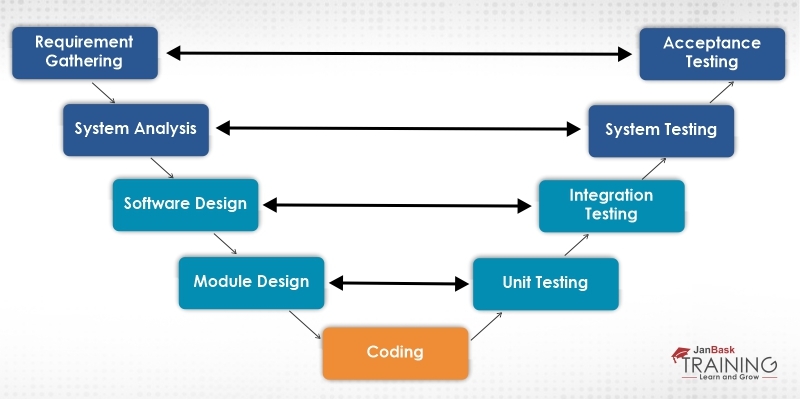25
JulGrab Deal : Flat 30% off on live classes + 2 free self-paced courses - SCHEDULE CALL
SDLC commonly known as Software Development Life Cycle is the engineering principle behind any software or system development. Well, there are multiple development lifecycles, but the basic idea behind all of them are the same. The basic idea revolves around planning, analysis, designing, implementation, and maintenance. This lifecycle can be applied for hardware configurations, software configurations or a project dealing with a combination of both. It is always carried out in phases and follows a defined process. SDLC is not a methodology, but phases of lifecycle development. All other frameworks which work on this principle as the bottom line forms the methodologies.

The sequential model in the software industry is known as the waterfall model. It is the initial software development model, which was being used in the IT industry. This model came into existence in 1970, as introduced by Winston Royce. This is divided into multiple phases where each phase is supposed to perform some activity. The behavior of a particular model is quite linear in aspect, and all phases have to be completed prior to the start of the next one.

The way agile works is totally opposite in the way waterfall functions. Agile functions with a combination of iteration and incremental approach in the process. Agile methodology accepts quick change and works in an iterative method to achieve it. It focuses on process adaptability and client satisfaction with the rapid development of the product. Agile does not become rigid like a waterfall, but it believes that every project is different and unique, and they need to be handled differently to meet the business goals.
There are four agile manifesto which is being practiced -
Learn Business Analyst in the Easiest Way

Read: What is the Average Business Analyst Salary in Canada
The famous agile frameworks are - Scrum, Kanban, XP and SAFe
Scrum is one of the frameworks of agile and is very widely used especially in product companies. Scrum mostly works on a simple method of experience. It is divided into sprints which might range from 2 to 3 weeks. The code progression and functionality testing should be completed within that period for a given set of tasks. These tasks are being taken from the sprint backlog which in turn is derived from the product backlog.
Kanban works on real-time communication of capacity and the idea of being transparent. Kanban is so much in use these days, that it is seeing tremendous growth but actually Kanban came into existence in the 1940’s where Toyota implemented this process to perform re-engineering for its business functions. It has a separate board known as Kanban board which acts as a display for showing the work in progress of the entire Kanban Team.
XP known as Extreme Programming focuses on very frequent change and always works towards fulfilling customer demands. The developers do very quick and frequent releases. It sometimes involves collaborative programming and performing extensive code review and unit testing.
SAFe is the world’s leading and fastest-growing agile framework which is helping complex organizations to achieve benefits of the agile model. It works on a predictable pattern and schedule and helps to deliver value to the business. The main idea behind SAFe is that it focuses on the Lean-Agile model, and engages even leadership for training and learning.
As the name suggests, this model gets into V shape and follows a sequential flow. The model is completely known as the Verification and Validation Model. It is sometimes also called as the expanded version of the waterfall model This model visualizes testing in each step during the software development lifecycle.
The principles of V-Model are -

The industry calls it as no planning model, maybe because of the way it functions.RAD stands for Rapid Application Development and focuses on iterative development and prototyping approach. The whole idea revolves around rapid delivery and meeting the customer needs. The approach is to collect client feedback through workshops, different meetings and work on the prototype coding and testing mechanism. Since it involves a minimum amount of planning, it is derived as a working model and specializes in a product component.
Read: Business Process Modeling Notation Is So Famous, But Why?

The project which works under the RAD model has an iterative approach with a smaller team, comprising a group of developers, subject matter experts, and domain experts who all focus on rapid and quick delivery.
Let’s see the use - cases where the RAD model can be used -
Business Analyst Training & Certification

When the iterative approach and the sequential phase of development combines, spiral model forms. That means the spiral model is a combination of waterfall and linear development process. This model leads to incremental product release with each iteration passing by forming a spiral pattern.
Four phases in the spiral model are -

This model is widely used in the IT industry because it easily gets synced with any product development, as it is a blend of an iterative and linear approach. Let’s see the use - cases when spiral model can best make use of -
Read: How To Make Your Product Stand Out With Process Flow Diagram?
Business Analyst Training & Certification

Rational Unified Process is linked with agile methodology because it follows the iterative development approach. This framework was created by Rational Software Corporation, a division of IBM in 2003. It is a more adaptive framework where organizations and project teams select the processes which are beneficial to fulfill their development needs. The development framework cycle followed in RUP is also known as the RUP hump chart.
RUP works in four phases in the development method where each phase is bound to work around business modeling, analysis and design, implementation, testing and then deploying the product. The four phases are -
Business Analyst Training & Certification

So by now, you all might have understood how strong the software development life cycle is and what wonders it can do in the project management world. Actually, not only IT but this framework if applied properly can solve problems of any project across various domains and industries. Like I always, enjoy all your learnings with positiveness and a zeal to accelerate it. Happy Learning Learners !!
Read: 10 Best Power BI Project Ideas To Boost Your Skills
 Pinterest
Pinterest
 Email
Email
I believe in knowledge sharing and bringing change in people's lives. As a business analyst by profession, I love to explore everything about the way businesses should drive. I keep in touch with the latest business analysis updates.

Cyber Security

QA

Salesforce

Business Analyst

MS SQL Server

Data Science

DevOps

Hadoop

Python

Artificial Intelligence

Machine Learning

Tableau
Search Posts
Related Posts
15 Business Analyst Project Ideas For a Compelling Resume
![]() 1.7k
1.7k
What is the Future Career Path and Scope of Business Analyst
![]() 211.3k
211.3k
What is a Business Analyst? Technical & Non-technical BA Skills
![]() 2.3k
2.3k
Why Learning Stakeholder Analysis is Important for the Business Growth?
![]() 6.6k
6.6k
Discovering the Underlying Competencies of Business Analyst
![]() 5.8k
5.8k
Receive Latest Materials and Offers on Business Analyst Course
Interviews